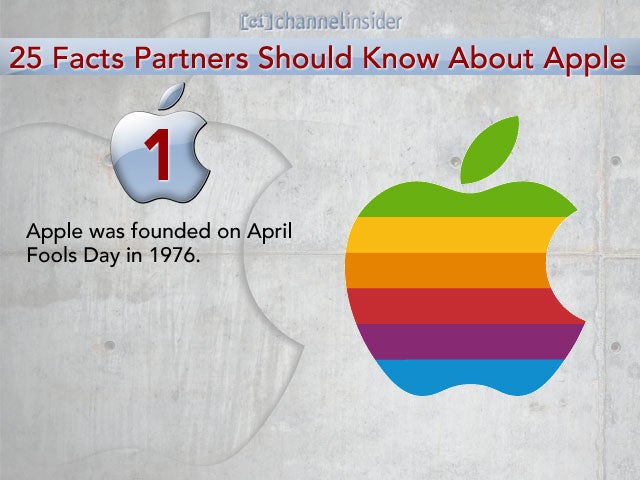 25 Facts Partners Should Know About Apple
25 Facts Partners Should Know About Apple
Apple was founded on April Fools Day in 1976.
 No Title
No Title
Its first slogan was "Byte into an Apple."
 No Title
No Title
The first product the company sold was just a computer kit, Apple I, which came with a motherboard, CPU and RAM.
 No Title
No Title
The Apple IIe spent the longest time on shelf among all other Apple models, lasting on the market for almost 11 years.
 No Title
No Title
Before Apple hit it out of the park with the Macintosh brand, it crashed and burned with the Apple III and Apple Lisa–both were regarded as important technological advancements for the company but neither took off with buyers.
 No Title
No Title
Lisa was the first PC to use a GUI. For years, Apple locked horns with Microsoft in the courts with what many regard as a well-founded claim that the company stole Lisa’s ‘look and feel’ for Windows.
 No Title
No Title
Apple’s rise as a marketing super power first started with its landmark Macintosh launch commercial during the 1984 Super Bowl, a stylistic video directed by Ridley Scott.
 No Title
No Title
After being dominated by Wintel computers for much of the 1990s, Apple revamped its image with the iMac in 1998, which helped make the year the first profitable one in three years.
 No Title
No Title
Many Apple fanboys may not know it, but in 1997 Microsoft helped float Apple during some of its darkest days with a $150 million investment.
 No Title
No Title
Today Apple has more than 34,000 employees.
 No Title
No Title
In 2009 Apple brought in $42.91 billion in revenue.
 No Title
No Title
At the end of May, 2010, Apple’s market capitalization was measured at $222.12 billion.
 No Title
No Title
That market cap measurement was significant, as Apple beat out Microsoft’s $219.18 billion–proof to many that Apple is now more valuable than Microsoft.
 No Title
No Title
Apple has the most valuable brand and repurchase loyalty of any computer manufacturer, according to J.D. Power.
 No Title
No Title
There are currently over 200,000 applications available through the Apple Apps Store.
 No Title
No Title
In its first month on the market, iPad shipped out to 1 million users.
 No Title
No Title
In addition to its resellers and Apple Store distribution channels, the company chose to partner with Best Buy to push out the iPad.
 No Title
No Title
Apple has long had an on-again-off-again with channel partners, particularly since the unveiling of the first Apple Store in 2001.
 No Title
No Title
Three years after that first store opened, a number of Apple resellers filed suit against the company claiming that it offered the official stores bigger discounts and a more reliable product pipeline than to independent dealers.
 No Title
No Title
Apple eventually settled with the plaintiffs with that suit, but rumors still persist amongst partners that the practices still exist.
 No Title
No Title
Some Apple partners believe that the launch of the iPad may actually have started a new era in opportunities for those in the channel who can help businesses to integrate the device into enterprises.
 No Title
No Title
Apple may be looking to reconnect with the channel–it recently launched a new channel site that offers greater transparency into its channel ecosystem and what roles the company sees various partner types taking with customers.
 No Title
No Title
In concert with its sleek marketing legacy, Apple has also kept a tight reign over product prototypes and pre-release announcements.
 No Title
No Title
However, this spring the company suffered a big black eye when an Apple engineer left a prototype 4G iPhone on a beer garden barstool.
 No Title
No Title
When the man who found it sold it to tech news outlet Gizmodo, Apple may have made matters worse from a PR perspective when it pushed to have the home of the Gizmodo’s newsman in charge searched and his computer belongings seized.

